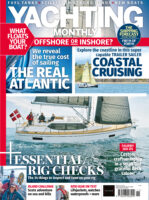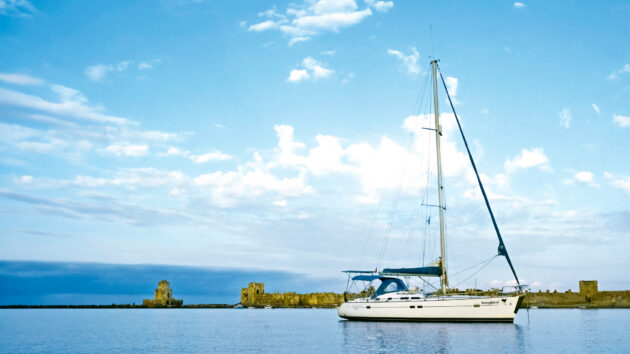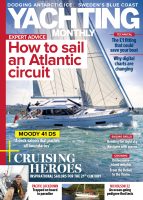Steve and his wife Gael sail anti-clockwise round the Peloponnese, braving the legendary Cape Maleas along the way
Good luck going round the Peloponnese,’ smiled the seasoned sailor as I told him our plans. He stood at the dock on the Greek Island of Lefkada, looking critically at our yacht as we made last-minute preparations. ‘I ripped my mainsail going round there last year.’ With that the bearded seadog gave us a friendly wave and we cast off our stern lines. Were we biting off more than we could chew?
For the last two years my wife Gael and I have kept Songbird, our Beneteau 423, in Corfu. We have been cruising the Ionian Islands, one of the great sailing areas of the Mediterranean. It is beautiful, fascinating and varied. But secluded it is not.
In spring 2024 we were in search of new sites and quieter anchorages. We wanted a bigger adventure… but not too big. Over winter we had studied our charts and decided a circumnavigation of the Peloponnese in the spring was just the ticket. We would travel anti-clockwise and return through the Corinth Canal.
The Peloponnese peninsula is the shape of a four-fingered hand hanging down below Greece.
It is severed from the rest of the country by the Corinth Canal – effectively making it an island. The peninsula divides two very popular sailing areas – the Ionian in the west and the Aegean in the east. But relatively few cruising yachts make the long journey around the coast, preferring the short cut through the canal.

Steve coming into Koroni Bay. We dropped anchor here in the lee of the ancient Venetian fortress. Photo: Gael Allan
Legendary location
Cape Maleas is at the tip of the third finger. It is where our seadog friend had ripped his mainsail and it has a reputation that is – literally – legendary. It is here that Odysseus was blown off course by a huge storm and remained lost for ten years. Today the charts are equally daunting when describing this cape. ‘Sudden gusts are sent down the mountains with north winds which are strong enough to rip your sails apart, to break the mast or even cause the boat to capsize.’
In the spirit of the well-known phrase ‘hope for the best, but plan for the worst’ we checked our storm jib and gave the deep third reef in the mainsail a try. But it felt strangely calm as we left the Ionian islands behind us that first day and headed for the mainland coast.
The prevailing winds are northwesterly so we sailed south on just our 140 percent genoa foresail and headed downwind for Katakolo, our first stop on the peninsula. On the way we were joined by dolphins and passed endangered loggerhead turtles. This area is one of their most important breeding grounds.

Before we set off we bought a small tender that can be hauled aboard single- handed. As we were at anchor most nights it came in very handy. Photo: Gael Allan
We gybed around the headland and the port of Katakolo lay ahead. It is a harbour for the enormous cruise ships to visit the ancient site of Olympia. We moored stern-to in the Mediterranean style, dropping our anchor at a distance to avoid the huge abandoned chains in the harbour.
It is a train ride to Olympia and the station is just 100 metres from the quay. It was a glorious slow trundle past the olive orchards as the train driver tooted his horn and waved to his friends.
Free as a bird
Next morning we continued south, completing tasks as we sailed. We have owned Songbird for two years now. When we bought her she was called Evelyn May – but one of the joys of having our own yacht is personalising her. Now that we had changed her name Gael made a flag and we put her new name on the tender.
Later that day we sailed past the village of Marathopolis where an enormous crane was rebuilding the destroyed mole. In 2018 the village was in the path of cyclone Zorbas. This was the first ever officially documented ‘Medicane’. This is a Mediterranean hurricane, a new phenomenon of our changing climate. On 29 September that year, the Force 11 cyclone had hurled yachts and fishing boats onto the land and ripped the boulders of the mole into the sea. It was a sobering reminder that this calm sea could be violent.
Article continues below…
We anchored at the ancient port of Methoni, in the lee of a medieval fortress. Just one other yacht was with us. The Peloponnese has some of the most magnificent castles in Europe, testament to centuries of fighting by the Franks, Venetians and Ottomans.
We anchored in a sheltered spot close to the high medieval battlements. The sea bed was thick sand and made great anchor holding from the prevailing winds. In the evening, we studied the forecast. There was some weather approaching in the next couple of days and we needed to find a place to sit it out. We were not keen to be stuck on anchor if it turned out to be a long blow.

The beautiful anchorage at Elafonisos Island. Yachts stay here waiting for suitable weather to cross Cape Maleas, just a few miles to the east. Photo: Gael Allan
Medieval mooring
Next morning, we headed around the remote Cape Akritas, reaching the tiny town of Koroni. This is one of the most gorgeous towns of the Peloponnese and again we were the only yacht in the harbour. There is probably not a more magnificent anchorage in the Peloponnese, in the lee of the grand medieval castle surrounded by terracotta tiled houses.
We walked up the hill and fell into conversation with Castos, a 90-year-old former sea captain. Around the coast of Greece you are never far from someone with great knowledge of the sea. We discussed the strong winds that were coming and I asked his opinion on the best place to hole up. He sucked in his breath and then said, ‘Not here. Go to Kalamata.’ We immediately decided to obey his advice.
By the time we had clambered back onboard Songbird, the calm water in the bay was turning into ripples – and after we had raised the anchor those ripples had become waves. We needed to make a speedy exit.
Kalamata is at the head of the gulf, just 20 miles to our north. The sailing was exhilarating. At first it was a good 20 knots and we set sail close hauled with a reef in both main and foresail. Then the wind suddenly died and we flapped in a dead calm.

A storm approaching at Kalamata. This is the only marina on the south of the peninsula but a great place to moor if there is bad weather approaching. Photo: Gael Allan
When the wind is changing direction, I’ve found there is usually this moment of quiet. Then it picked up from the east and soon we were moving at speed again. These changeable winds are typical of this area, surrounded by mountains on three sides. It’s fun and kept us on our toes.
Seeking shelter
Kalamata is the only big town in the Peloponnese. It also has the only marina and it was good to be tucked behind its wall during the Force 7-8 blow. When there is bad weather, we usually hole up and hire a car. We spent two days exploring the huge limestone gorges of the interior and the remains of ancient citadels.
After the weather cleared it was time to set off again. Our next stop was the village of Kardamyli, on the east coast of the Gulf of Messinia. It was a beam reach with full sail all the way.
As we arrived in the empty bay we peered over the side through the crystal-clear water, searching for a sandy patch to drop anchor in the empty bay. We tucked in behind a steep headland which protected us neatly from the south wind.

Steve raising the sail on Songbird. Photo: Gael Allan
We took our tiny tender and motored to the village. It was Easter Sunday for the Orthodox Church and Greek families were celebrating by eating lamb in the restaurant that looks down on the bay. We were being watched by many expert eyes as we landed the dinghy on the tiny rocky beach and we made doubly sure we were on our most seamanlike behaviour as we jumped out into the surf and pulled it up the shingle.
The next day we set our sails close hauled and sailed south, watching the austere coastline of the Mani peninsula slip by.
As we rounded Cape Tainaron, the wind was really picking up. This bleak and atmospheric place is reputed to be the entrance to Hades – and the pilot book warned us there were no safe anchorages here – so we kept on going to the small town of Gythio.
Few cruising yachts come here, but the fishing harbour has a strong and safe wall. Before we arrived, we rang Nikos, who takes the lines for the visiting ferry, to ask his advice. He came to the harbour and showed us a spot not reserved for the fishing boats and told us to drop our anchor at least 60 metres out. That way we would be safe in the predicted winds and also miss the old chains stuck in the harbour bed. Again, local knowledge saved the day.
For three days the wind blew strongly. We rigged midship lines and hunkered down. We were glad that we were snuggled in next to an ancient trawler which loomed over us and provided a windbreak. I asked a local fisherman if the trawler was going anywhere in the next few days. ‘The only way it is going is down,’ he said.

We sheltered in the port of Gytheio, mooring in the lee of an ancient fishing boat. Photo: Gael Allan
A little bit of heaven
All blows come to an end and finally we set off for the spectacular anchorage of Elafonisos. It is a little bit of heaven – two miles of sand backed by dunes held together by ancient and gnarled juniper trees. Just two other yachts shared the bay with us.
This is the traditional holding pen for yachts heading east and waiting for good weather. Cape Maleas is just a few miles away. This was the headland the old seadog we met at the start of our trip had warned us would end in tears. We studied the forecasts and discussed options.
Next morning after swimming in the cold turquoise water we set off downwind. We glided along at four knots on just our genoa, keeping well out of the way of the huge freighters and oil tankers in the busy shipping lane. Then as we reached Cape Maleas, the wind died entirely.

Songbird yacht anchored in the bay at the town of Koroni. Photo: Gael Allan
So, to our shame, we ended up motoring around the infamous Cape. As we passed the headland we arrived in the Aegean. To our north were the familiar cruising grounds of Poros, Spetses and Hydra.
From then on, the harbours and anchorages became gradually more crowded. We slowly made our way back up the coast, stopping for a few days at the romantic medieval town of Monemvasia. From there we weaved our way between the Saronic islands. Then it was through the Corinth Canal and back home to Corfu.
We arrived in Corfu Town seven weeks after we had left, with just over a thousand miles travelled. Despite the seadog’s warning, our mainsail was still intact and the legendary storms had turned out to be just that – quite legendary. As we had hoped, it had been an adventure, but not too big.
This article is a part of our Zhik Spirit of Adventure Awards.
Enjoyed reading this?
A subscription to Yachting Monthly magazine costs around 40% less than the cover price, so you can save money compared to buying single issues.
Print and digital editions are available through Magazines Direct – where you can also find the latest deals.
YM is packed with information to help you get the most from your time on the water.
-
-
- Take your seamanship to the next level with tips, advice and skills from our experts
- Impartial in-depth reviews of the latest yachts and equipment
- Cruising guides to help you reach those dream destinations
-
Follow us on Facebook, Twitter and Instagram.





